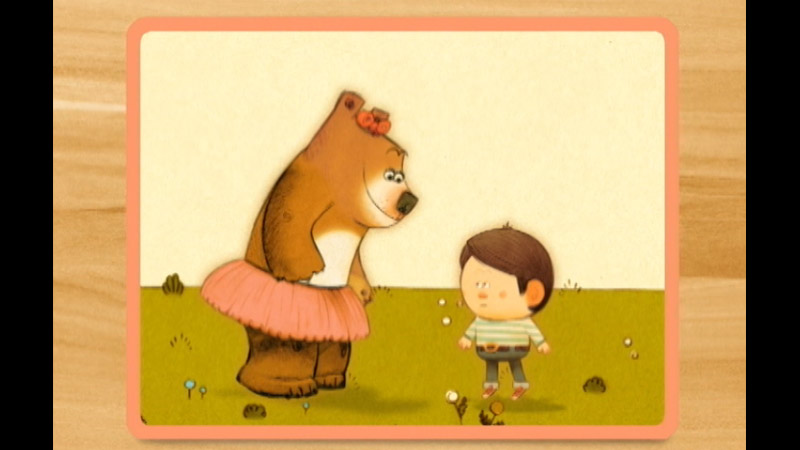Description Key - How to Describe
- General
- Point of View and Narrative Tense
- Timing & Rate
- Vocabulary and Language
- Objectivity and Interpretation
- Music
- Ambient Background Sounds and Sound Effects
- Text On-Screen
General
- To explain basic concepts, use vocabulary that is meaningful to students who are blind or visually impaired. For example, refer to direction in terms of proximity to landmarks, position (in front/behind/left/right), clock analogies (at 3 o'clock), and cardinal directions (to the North). References to distances might include personal referents ("The length of your arm") and standard measurements (e.g., inches, feet, miles, or centimeters).
- Whenever possible, describe the visual action in terms of the viewer's body, or use body terms that children with visual impairment can relate to their own bodies.
 Clip from Frog on His Own
Clip from Frog on His Own - Describe movement/directions when they are important to understanding the scene or concept under discussion.
 Clip from Moko: Marine Currents Mystery
Clip from Moko: Marine Currents Mystery - Describe shapes, sizes, and other essential attributes of objects by comparison to objects that are familiar to the intended audience.
 Clip from Adaptive Function of Form: The Beauty of Ugly
Clip from Adaptive Function of Form: The Beauty of Ugly
Point of View and Narrative Tense
- Deliver description in present tense, in active voice (e.g., "Ted breaks the window," is preferable to, "The window was broken by Ted.")
- Use third-person narrative style to show neutrality and noninterference.
- Provide visual perspective as appropriate and as time allows.
 Clip from The Great Whales
Clip from The Great Whales - Use the first-person narrative to engage the audience in a specific interaction.
Occasionally, the audience is directly engaged. An on-screen character might ask the audience to "Watch me and follow along," or an instructor might ask, "Can you see what color the liquid is turning in the beaker?" This is a common occurrence in children's shows, and it sometimes occurs in educational productions. In such cases, it is necessary for the audience members to know that it is they who are being addressed (as opposed to an on-screen character). One way to accomplish this is to refer to the audience as "you."
Timing and Rate
- Speak clearly and at a rate that can be understood. Conform the rate of the description to the pace of the program.
- Let pauses or quiet moments pass without a description when appropriate to support the mood. Do not try to fill every pause. Allow atmosphere and background sound to come through.
 Clip from The Great Whales
Clip from The Great Whales - Avoid describing over audio that is essential to comprehension. Describe over dialogue, music, sound effects, and other key audio only when necessary to impart key information.
Clip 1: Original Audio

Clip 2: Description

- Voice descriptions as close to the action as possible. When time is limited, describe the images that are on the screen, although there may be times when leading the action (describing before the image appears) is necessary.
 Clip from Sea Rescue: A Tight Spot
Clip from Sea Rescue: A Tight Spot
Vocabulary and Language
- Use age-appropriate vocabulary, sentence structure, and pace to match the age of the intended audience. Begin by adjusting the description at the word level. (For a listing of STEM description vocabulary for early learners, visit: http://www.dcmp.org/descriptionkey/vocab/stem.html)
 Clip from Children Make Terrible Pets
Clip from Children Make Terrible Pets - Use clear, concise language that is accurate and content appropriate. Good pronunciation, diction, and enunciation are essential.
- Give descriptions in complete sentences if possible. If time is severely limited, sentence fragments may be used.
- Use pronouns only when it is clear to whom or what the pronoun refers.
- To identify something by name or to refer to something that has already been addressed, use the definite article "the." To introduce a subject or object, use the indefinite articles "a" or "an."
- Use vivid language that best matches the program content.
- Formal speech is preferred over colloquialisms and slang, except where use of the latter is appropriate to the content. For example, colloquial language such as "y'all," "gonna," "wanna," and slang such as "phat," "radical," and "smokin'" are often regionalized and may have a short life span.
- When introducing new terms, objects, or actions, label them first, and then follow with the definitions.
 Clip from The Great Whales
Clip from The Great Whales - Identify words that have multiple meanings; be sure that the intended meaning is conveyed.
 Clip from Doppler On Wheels: The biggest 'dish' on the Road
Clip from Doppler On Wheels: The biggest 'dish' on the RoadObjectivity and Interpretation
- Describe objectively without personal interpretation, censorship, or comment. Descriptive adjectives are important in enhancing a scene, but must not reflect personal view.
- Consider when it is appropriate to summarize.
Note: In a montage/series of images, it may not be feasible to describe each image as it appears. At the start of the montage/series, a describer may opt to summarize the content of the images or those that directly relate to comprehension of content and add more detail if and when possible. Clip from Coral Reefs: Ecological Communities
Clip from Coral Reefs: Ecological CommunitiesMusic
- Treat lyrics as dialogue. If descriptions are needed, wait until verses are repeated. In certain songs, there may be learning goals associated with the words, rhythm, and melody of the song, so judge carefully.
Note: This rule does not apply to background music that serves no contextual or educational purpose to the production.
Ambient Background Sounds and Sound Effects
- Generally, as with music, describe over the original audio only if there is important information to be conveyed. Determine whether the description of the ambient background sounds or sound effects is key to understanding the scene.
- Describe the source of sounds that may not be immediately recognizable within the program but are pertinent to understanding and appreciation of the content. Commonly recognized sounds that occur in context do not need description.
 Clip from Predator & Prey: Adapt to Survive
Clip from Predator & Prey: Adapt to Survive- Good description enhances and complements the content. If necessary, describe only over the least consequential dialogue or original audio.
Text On-Screen
- If text on the screen is central to understanding, establish a pattern of on-screen words being read. This may include making an announcement, such as "Words appear," along with a changed tone of voice. Once a pattern has been established, a change in the tone of voice can be used alone.
 Clip from Miracle of the Human Body: The Digestive and Renal System
Clip from Miracle of the Human Body: The Digestive and Renal System - Read subtitled speech verbatim. Subtitles are often used to translate a speaker's words into a program's native language as well as to compensate for natural or artificial factors that render spoken words incomprehensible (e.g., a speech impediment or large amounts of ambient background sound).
 Clip from See What I'm Saying: The Deaf Entertainers Documentary
Clip from See What I'm Saying: The Deaf Entertainers Documentary - If a program is titled, provide the title in the description, unless it is conveyed in the existing narration or voiceover. Special cases like music videos or short-form educational clips might require additional description of unspoken or untitled content (such as the name of the artist in a music video); these are handled on a case-by-case basis with input from the client.
- Consider the differential purposes of opening credits, on-screen text, and closing credits; let those purposes dictate how they are treated in the description.
Note: When credits overlap visual and/or audio content, read them when time allows.Note: It will be necessary to read credits whenever it is contractually required. These issues may need to be addressed by your legal team.
Tags:

